A requirement for cyclin D3-cyclin-dependent kinase (cdk)-4 assembly in the cyclic adenosine monophosphate-dependent proliferation of thyrocytes
- PMID: 9508775
- PMCID: PMC2132659
- DOI: 10.1083/jcb.140.6.1427
A requirement for cyclin D3-cyclin-dependent kinase (cdk)-4 assembly in the cyclic adenosine monophosphate-dependent proliferation of thyrocytes
Abstract
In different systems, cyclic adenosine monophosphate (cAMP) either blocks or promotes cell cycle progression in mid to late G1 phase. Dog thyroid epithelial cells in primary culture constitute a model of positive control of DNA synthesis initiation and G0-S prereplicative phase progression by cAMP as a second messenger for thyrotropin (TSH). The cAMP-dependent mitogenic pathway is unique as it is independent of mitogen-activated protein kinase activation and differs from growth factor-dependent pathways at the level of the expression of several protooncogenes/transcription factors. This study examined the involvement of D-type G1 cyclins and their associated cyclin-dependent kinase (cdk4) in the cAMP-dependent G1 phase progression of dog thyroid cells. Unlike epidermal growth factor (EGF)+serum and other cAMP-independent mitogens, TSH did not induce the accumulation of cyclins D1 and D2 and partially inhibited the basal expression of the most abundant cyclin D3. However, TSH stimulation enhanced the nuclear detection of cyclin D3. This effect correlated with G1 and S phase progression. It was found to reflect both the unmasking of an epitope of cyclin D3 close to its domain of interaction with cdk4, and the nuclear translocation of cyclin D3. TSH and EGF+serum also induced a previously undescribed nuclear translocation of cdk4, the assembly of precipitable cyclin D3-cdk4 complexes, and the Rb kinase activity of these complexes. Previously, cdk4 activity was found to be required in the cAMP-dependent mitogenic pathway of dog thyrocytes, as in growth factor pathways. Here, microinjections of a cyclin D3 antibody showed that cyclin D3 is essential in the TSH/ cAMP-dependent mitogenesis, but not in the pathway of growth factors that induce cyclins D1 and D2. The present study (a) provides the first example in a normal cell of a stimulation of G1 phase progression occurring independently of an enhanced accumulation of cyclins D, (b) identifies the activation of cyclin D3 and cdk4 through their enhanced assembly and/or nuclear translocation, as first convergence steps of the parallel cAMP-dependent and growth factor mitogenic pathways, and (c) strongly suggests that this new mechanism is essential in the cAMP-dependent mitogenesis, which provides the first direct demonstration of the requirement for cyclin D3 in a G1 phase progression.
Figures
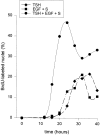





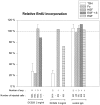
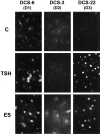

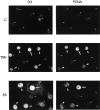

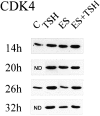


Similar articles
-
Transforming growth factor beta(1) selectively inhibits the cyclic AMP-dependent proliferation of primary thyroid epithelial cells by preventing the association of cyclin D3-cdk4 with nuclear p27(kip1).Mol Biol Cell. 2000 Mar;11(3):1061-76. doi: 10.1091/mbc.11.3.1061. Mol Biol Cell. 2000. PMID: 10712520 Free PMC article.
-
Cyclic AMP-dependent phosphorylation of cyclin D3-bound CDK4 determines the passage through the cell cycle restriction point in thyroid epithelial cells.J Biol Chem. 2003 Jul 18;278(29):26533-40. doi: 10.1074/jbc.M302492200. Epub 2003 Apr 30. J Biol Chem. 2003. PMID: 12730225
-
Differential utilization of cyclin D1 and cyclin D3 in the distinct mitogenic stimulations by growth factors and TSH of human thyrocytes in primary culture.Mol Endocrinol. 2006 Dec;20(12):3279-92. doi: 10.1210/me.2005-0515. Epub 2006 Aug 17. Mol Endocrinol. 2006. PMID: 16916940
-
D-type cyclins.Trends Biochem Sci. 1995 May;20(5):187-90. doi: 10.1016/s0968-0004(00)89005-2. Trends Biochem Sci. 1995. PMID: 7610482 Review.
-
The role of cyclic AMP and its effect on protein kinase A in the mitogenic action of thyrotropin on the thyroid cell.Ann N Y Acad Sci. 2002 Jun;968:106-21. doi: 10.1111/j.1749-6632.2002.tb04330.x. Ann N Y Acad Sci. 2002. PMID: 12119271 Review.
Cited by
-
Overexpressed cyclin D3 contributes to retaining the growth inhibitor p27 in the cytoplasm of thyroid tumor cells.J Clin Invest. 1999 Oct;104(7):865-74. doi: 10.1172/JCI6443. J Clin Invest. 1999. PMID: 10510327 Free PMC article.
-
cAMP-dependent activation of mammalian target of rapamycin (mTOR) in thyroid cells. Implication in mitogenesis and activation of CDK4.Mol Endocrinol. 2010 Jul;24(7):1453-68. doi: 10.1210/me.2010-0087. Epub 2010 May 19. Mol Endocrinol. 2010. PMID: 20484410 Free PMC article.
-
Monoclonal antibodies to activated CDK4: use to investigate normal and cancerous cell cycle regulation and involvement of phosphorylations of p21 and p27.Cell Cycle. 2022 Jan;21(1):12-32. doi: 10.1080/15384101.2021.1984663. Epub 2021 Dec 16. Cell Cycle. 2022. PMID: 34913830 Free PMC article.
-
Switch in signaling control of mTORC1 activity after oncoprotein expression in thyroid cancer cell lines.J Clin Endocrinol Metab. 2014 Oct;99(10):E1976-87. doi: 10.1210/jc.2013-3976. Epub 2014 Jul 16. J Clin Endocrinol Metab. 2014. PMID: 25029414 Free PMC article.
-
Differential regulation of cyclin-dependent kinase 4 (CDK4) and CDK6, evidence that CDK4 might not be activated by CDK7, and design of a CDK6 activating mutation.Mol Cell Biol. 2009 Aug;29(15):4188-200. doi: 10.1128/MCB.01823-08. Epub 2009 Jun 1. Mol Cell Biol. 2009. PMID: 19487459 Free PMC article.
References
-
- Ajchenbaum F, Ando K, De Caprio JA, Griffin JD. Independent regulation of human D-type cyclin gene expression during G1 phase in primary human T lymphocytes. J. Biol Chem. 1993;268:4113–4119. - PubMed
-
- Baldin V, Lukas J, Marcotte MJ, Pagano M, Draetta G. Cyclin D1 is a nuclear protein required for cell cycle progression in G1. Genes Dev. 1993;7:812–821. - PubMed
-
- Baptist M, Dumont JE, Roger PP. Demonstration of cell cycle kinetics in thyroid primary culture by immunostaining of proliferating cell nuclear antigen: differences in cyclic AMP-dependent and -independent mitogenic stimulations. J Cell Sci. 1993;105:69–80. - PubMed
-
- Baptist M, Dumont JE, Roger PP. Intercellular heterogeneity of early mitogenic events: cAMP generalizes the EGF effect on c-Fos protein appearance but not on MAP kinase phosphorylation and nuclear translocation in dog thyroid epithelial cells. Exp Cell Res. 1995;221:160–171. - PubMed
-
- Baptist M, Lamy F, Gannon J, Hunt T, Dumont JE, Roger PP. Expression and subcellular localization of CDK2 and cdc2 kinases and their common partner cyclin A in thyroid epithelial cells: comparison of cyclic AMP-dependent and -independent cell cycles. J Cell Physiol. 1996;166:256–273. - PubMed
Publication types
MeSH terms
Substances
LinkOut - more resources
Full Text Sources
Molecular Biology Databases

